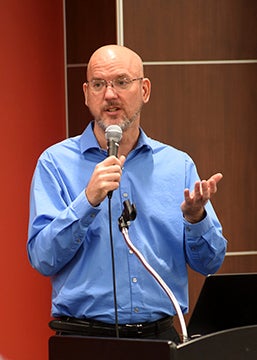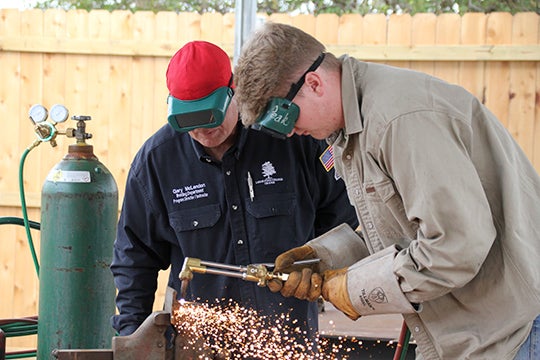BEYOND THE STORM — ABCs of cleanup: Port Arthur, DD7, Jefferson County rebuilding
Published 12:28 pm Tuesday, May 1, 2018

- Debris line the streets as residents clean up after flooding from Hurricane and Tropical Storm Harvey. (David Ball/The News)
Armando Gutierrez, public works supervisor, said the first step after a natural disaster is to clean up. Seven months since Hurricane and Tropical Storm Harvey hit the area, he said the city of Port Arthur is moving from that phase and focusing on other infrastructure projects.
“We’re doing mitigation to get back to where we’re supposed to be,” Gutierrez said. “FEMA (Federal Emergency Management Agency) put us in Category A which means they could assist with debris pickup for six months only. A lot of people that were delayed are back in their homes. The piles of debris changed characteristics. It was new construction material, which means people are rebuilding and that’s good news. That inspires me.”
The first six months after Harvey, debris contractor Crowder Gulf picked up 500,000 cubic yards of trash. The Texas Department of Transportation picked up a little less than 20,000 cubic yards and city crews picked up from 30,000 to 40,000 for a total of around 600,000 cubic yards of debris. During an average year 200,000 cubic yards of trash is picked up and taken to the landfill.
Another infrastructure project that was being planned before Harvey was a program to repair streets in the city due to the public’s request.
“We’ll be starting the street program very soon,” he said. “Maybe in two to three weeks, even if it’s one street to begin with. I have a couple of good candidates to start.”
He said some streets may need redesigning. Others need resurfacing.
Reconstruction is more involved and takes longer to complete than resurfacing. Additionally, water and sewer lines may need to be repaired or relocated once street work starts.
The city has three drainage pump stations for stormwater at different locations in the city and one pump at each of the railroad crossings at Memorial Boulevard and Gulf Avenue. The three pumps stations are in the areas of El Vista, Montrose and Foster Estates.
Gutierrez said even though pumps sit high, they still had a problem with rising water from Harvey.
DD7 preparing for
next rain event
One area that figured prominently for infrastructure pertaining to Hurricane and Tropical Storm Harvey is the Jefferson County Drainage District 7.
Phil Kelley, general manager of DD7, said Mason Construction, the contractor, recently completed the repair of the breached levee near Valero Port Arthur Refinery on Highway 87. The breach occurred shortly before Harvey and cost $6 million to repair. DD7 was waiting on the U.S. Army Corps of Engineers to complete their Interim Risk Reduction Measures prior to Mason completing bracing of the levee.
Kelley said the breach was the only section of the 34-mile concrete wall where that occurred. An I-wall is in the place, but he said that’s no longer an
acceptable design since Hurricane Katrina. That section must be converted to an inverted concrete T-wall.
Kelley said it will be a huge and expensive project, an estimated $730 million cost share of 65 percent federal match, 35 percent local match, to replace all of the seawall. The Corps requested to create a Sabine to Galveston Study for levee systems improvements and build a seawall for Orange County. It’s in a supplemental bill project that passed Congress.
Likewise, DD7 requested the Corps to do a study on DD7’s system with possibly local cities joining in to share costs, 75-25. If the Corps funds additional monies it may be 100 percent federally funded but waiting for funding.
“I don’t think it’s possible to create a system to handle a Harvey (because all of the rainfall), but I can see we do a design to handle a 25-year frequency storm,” he said.
In the meantime, more detention areas can be created on a timely basis while waiting on the study to be completed. DD7 is seeking hazard mitigation grants to do so.
Lamar University is seeking grant research in building resilience in the area against flooding. DD7 will provide a letter of support in their effort.
Kelley also said diesel fuel is a big issue and DD7 is preparing for the upcoming hurricane season, building emergency fuel supplies services for a hurricane rain event or potential flooding. Fuel transport trucks and/or large portable fuel tanks may be placed at strategic pump stations.
Jefferson rehabbing roads, bridges
Jefferson County has much area to cover in its unincorporated areas.
For infrastructure, their focus is primarily repairing roads, structures and getting residents back into their homes since Hurricane and Tropical Storm Harvey.
Steve Stafford, engineering superintendent, said many roads were inundated by floodwaters with more damages assumed to show up in the future.
“The roadbed was underwater for four days,” Stafford said. “You can’t point fingers with a lot of the immediate damages. There was a lot of flooding. For instance, Hillebrandt Bayou (in LaBelle). There was a lot of culvert damage, not much road damage. There was substantial damage to homes there.”
He said Precinct 2 County Commissioner Brent Weaver set up three public meetings for homeowners to take applications for building permits. Stafford said it was “very handy” to talk to people one-on-one with maps.
Additionally, FEMA contractors inspected many houses.
The county rates substantial damage if the cost to repair a home is greater than half the value of the home. Substantial damage values to older homes may be too low to come into play.
“Some homes may have to be raised or rebuilt. I would like to see the money (disaster assistance) used to elevate homes instead so people can stay in their homes and not leave the county,” he said. “Some homes are in a bad location, some are built too low and they may need to be raised a couple of feet. It hurts a neighborhood to take away a home and then it’ll be off the tax rolls forever. I spoke with a guy who’s 72. He said he can’t afford to raise his house but he doesn’t want to leave.”
Stafford said many residents don’t realize they need to get a building permit to make repairs in unincorporated areas. Often permit fees are waived.
This story appeared in Volume 1 of The Port Arthur News Profile, April 8, 2018
More Profile




